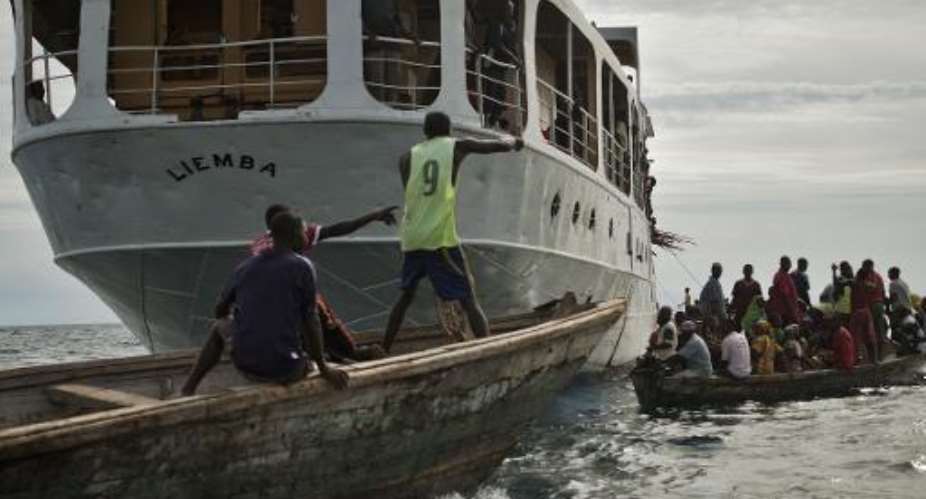Nairobi (AFP) - Refugees fleeing political violence in Burundi are arriving in Tanzania aboard a century-old German warship turned ferry that inspired the book and film 'The African Queen'.
The UN refugee agency has hired the MV Liemba, built in Germany in 1913, to carry fearful Burundian refugees along Lake Tanganyika to safety in neighbouring Tanzania.
"The MV Liemba is being used right now as the only boat to ferry people to Tanzania," said Joyce Mends-Cole, UNHCR's representative in Tanzania.
The vessel was once a feared gunboat defending the African lake for Kaiser Wilhelm II during World War I, but today it is a lifeline for refugees.
Official figures say that 23,000 refugees have arrived in Tanzania -- with 33,000 more going to Rwanda and the Democratic Republic of Congo -- but Mends-Cole said "numbers are rising fast".
The MV Liemba can carry 600 refugees at a time from the Burundi-Tanzania border town of Kagunga, to the port of Kigoma.
Each three-hour voyage costs UNHCR $10,500 (9,400 euros), or roughly $17.50 (16 euros) per person.
Thousands are fleeing Burundi amid political tensions surrounding a bid by President Pierre Nkurunziza to stay in power for a third term, which opposition and rights activists say is unconstitutional.
There are fears the crisis, which has left 20 dead in clashes in the capital Bujumbura, could plunge the small central African nation back into civil war.
In happier times the MV Liemba carries fare-paying customers for whom the ferry is the only mode of transport up and down the lake, but it is as critical in times of crisis, helping refugees find safety from violence and a way home when peace is restored.
- 'Repeat refugees' -
The 220-foot (67-metre) former steamer has carried refugees before, in 1997 and again in 2007 when it transported former refugees home to Burundi and Congo.
"It's very sad and disheartening that once again we're using this boat, that has been used to repatriate people in the past, to help them escape regional insecurity," said Mends-Cole. "Some of those we are picking up are the same ones we repatriated before."
The tale of the warship and its role in the battle for Lake Tanganyika inspired British novelist C.S. Forester to write his 1935 novel "The African Queen", later adapted by Hollywood in the 1951 movie of the same name starring Humphrey Bogart and Katherine Hepburn.
The MV Liemba began its life in a shipyard in Papenburg, Germany, in 1913 where it was named the Graf von Goetzen after German East Africa's former governor.
Before ever setting sail, the steamer was dismantled, packed into 5,000 numbered crates, and shipped to Dar es Salaam. It was then taken by railway and porter to the shore of Lake Tanganyika where it was reassembled in 1915, armed with cannon, and put to work defending the waters against Belgian and British soldiers.
For nearly a year the Graf von Goetzen dominated the lake, dwarfing all other ships. But when the outnumbered German land forces retreated, the warship was filled with cement and scuttled.
It was dredged up by the Belgians but sank in a storm soon after. In 1921 Churchill ordered it recovered and renamed MV Liemba, after the local name for the lake. It was put into service as a cargo and passenger ferry in 1927.
The original steam engines were only replaced with diesel ones in the mid-1970s.





 SSNIT must be managed without gov’t interference – Austin Gamey
SSNIT must be managed without gov’t interference – Austin Gamey
 Ejisu by-election could go either way between NPP and independent candidate — Gl...
Ejisu by-election could go either way between NPP and independent candidate — Gl...
 We never asked ministers, DCEs to bring NPP apparatchiks for returning officer r...
We never asked ministers, DCEs to bring NPP apparatchiks for returning officer r...
 No one denigrated the commission when you appointed NDC sympathizers during your...
No one denigrated the commission when you appointed NDC sympathizers during your...
 Used cloth dealers protests over delayed Kumasi Central Market project
Used cloth dealers protests over delayed Kumasi Central Market project
 A/R: Kwadaso onion market traders refuse to relocate to new site
A/R: Kwadaso onion market traders refuse to relocate to new site
 Dumsor: Corn mill operators at Kaneshie market face financial crisis
Dumsor: Corn mill operators at Kaneshie market face financial crisis
 Jamestown fishermen seek support over destruction of canoes by Tuesday's heavy d...
Jamestown fishermen seek support over destruction of canoes by Tuesday's heavy d...
 Election 2024: EC to commence voter registration exercise on May 7
Election 2024: EC to commence voter registration exercise on May 7
 Public schools rebranding: We’re switching to blue and white, we’re painting all...
Public schools rebranding: We’re switching to blue and white, we’re painting all...
